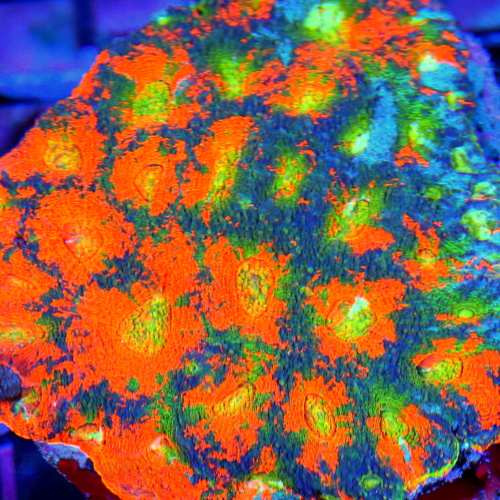Extreme Corals News and Updates
The Science Behind Coral Coloration: Enhancing Vibrancy in Your Tank
Understanding How Corals Get Their Colors and How to Enhance Their Vibrancy in Your Reef Tank
Coral colors are more than just stunning displays—they are a result of biological and environmental factors. This guide explains the science behind coral pigmentation, explores the role of lighting and nutrients, and provides actionable tips to maximize vibrancy in your reef tank.
by scott Shiles • February 19, 2025
Why Are Corals So Colorful? The Science of Coral Pigmentation
Corals are some of the most visually striking organisms in the ocean, displaying a breathtaking range of colors, from neon greens to deep purples and fiery reds. These colors are not just for show—they serve a biological purpose, helping corals adapt to their environment and interact with light.
Coral coloration is influenced by three key factors:
- Zooxanthellae Pigments (Brown Tones) – Symbiotic algae called zooxanthellae live within coral tissues and contribute to coral coloration through their natural pigments. These algae are responsible for brown and golden tones, which dominate in lower-light environments.
- Fluorescent Proteins (Neon Colors) – Corals produce fluorescent proteins that glow under blue and UV light. These proteins, such as green fluorescent protein (GFP), help protect corals from excess light and UV radiation.
- Non-Fluorescent Chromoproteins (Pastel Colors) – Some corals contain chromoproteins that absorb certain wavelengths of light, giving them a more muted, pastel appearance, such as deep pinks and purples.
Understanding these factors allows reefkeepers to optimize their tank conditions for maximum color expression.
How Lighting Affects Coral Coloration
The Role of Spectrum: Blue vs. White Light
Lighting plays the most significant role in enhancing coral coloration. Corals thrive under specific wavelengths of light that stimulate their fluorescent proteins.
- Blue and UV Light (420-470 nm): This spectrum penetrates deep into the ocean and enhances fluorescent greens, blues, and purples in corals.
- Red and Warm White Light (600+ nm): Less beneficial for corals, as most coral species do not absorb these wavelengths effectively.
- Balanced White Light: Necessary for natural growth, but should be supplemented with blue light for optimal coloration.
Best Lighting for Vibrant Coral Colors:
- Ecotech Radion XR15/XR30 G6: Provides adjustable blue-heavy spectrums for maximizing fluorescence.
- AI Hydra 32HD: Offers a customizable spectrum, allowing fine-tuned control over coral coloration.
- Kessil A360X: Uses a dense matrix LED to mimic natural sunlight while enhancing coral colors.
Lighting Tip: Set a schedule that includes gradual sunrise/sunset cycles with blue-light dominance during peak hours to enhance coral fluorescence.
The Impact of Water Quality on Coral Colors
Water parameters directly impact coral health and coloration. Stable and low-nutrient conditions prevent corals from browning out while supporting vibrant hues.
| Parameter | Ideal Range for Color Enhancement |
|---|---|
| Nitrates | 0.02 - 5 ppm |
| Phosphates | 0.01 - 0.05 ppm |
| Calcium | 400 - 450 ppm |
| Alkalinity | 8 - 12 dKH |
| Magnesium | 1250 - 1350 ppm |
How Nutrients Affect Coral Pigments
- Too many nutrients (high nitrates/phosphates) → Corals turn brown due to excess zooxanthellae.
- Too few nutrients (ultra-low nitrients) → Corals become pale or lose color due to lack of energy reserves.
- Balanced nutrients → Fluorescent proteins become more pronounced, creating vibrant colors.
Water Quality Tip: Use a protein skimmer and activated carbon to maintain optimal nutrient levels while performing regular water changes.
The Role of Nutrition in Coral Coloration
Corals are not just dependent on light; they also require targeted nutrition to sustain their metabolic processes.
Key Nutrients for Enhancing Coral Color
- Amino Acids: Essential for protein synthesis and pigmentation enhancement.
- Product Suggestion: Brightwell Aquatics Reef Blizzard or Red Sea AB+
- Fatty Acids & Carotenoids: Help support non-fluorescent pigments, giving corals deeper colors.
- Product Suggestion: Reef Nutrition Phyto Feast
- Trace Elements: Strontium, iron, and iodine enhance natural pigmentation in SPS and LPS corals.
- Product Suggestion: AquaForest Trace Elements
Feeding Tip: Target-feed LPS corals 2-3 times per week while dosing amino acids for SPS and soft corals to maintain vibrant colors.
Preventing Coral Color Fading: Common Mistakes to Avoid
Even experienced reefkeepers can run into problems with fading coral colors. Here are some common mistakes and how to correct them:
Too Much White Light
- Problem: Excessive white or warm light can encourage zooxanthellae overgrowth, causing corals to turn brown.
- Solution: Adjust lighting schedules to include more blue spectrum and limit white light to a few hours per day.
High Nitrates and Phosphates
- Problem: Nutrient spikes can cause corals to lose their vibrant hues and develop dull, brown tones.
- Solution: Implement regular water changes, protein skimming, and carbon dosing to keep nutrients within optimal levels.
Inconsistent Water Parameters
- Problem: Fluctuating alkalinity, calcium, and magnesium levels can stress corals, leading to poor coloration.
- Solution: Use an automated dosing system or test water parameters weekly to ensure stability.
Lack of Supplemental Feeding
- Problem: Corals may lack the necessary amino acids and fatty acids to maintain strong pigmentation.
- Solution: Incorporate a well-rounded feeding regimen that includes coral foods, amino acids, and plankton-based supplements.
Final Thoughts: Creating a Colorful and Thriving Reef Tank
Achieving stunning coral coloration requires a combination of proper lighting, stable water parameters, and essential nutrients. By understanding the science behind coral pigments, reefkeepers can optimize their tanks to bring out the most vivid colors possible.
Ready to take your coral coloration to the next level? Explore our collection of vibrant, aquacultured corals at ExtremeCorals.com and bring a spectrum of color to your reef tank today.

